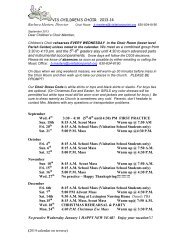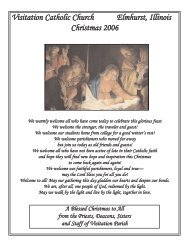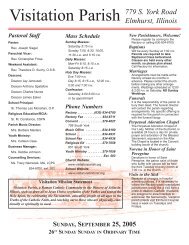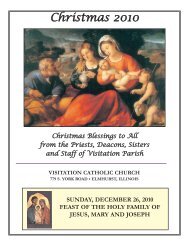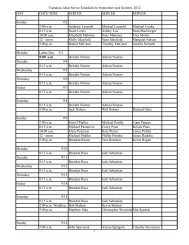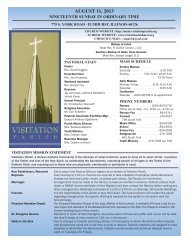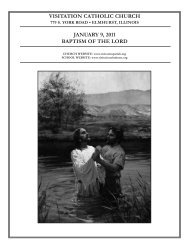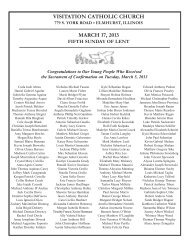Feb. 1, 2009 Bulletin - Visitation Parish
Feb. 1, 2009 Bulletin - Visitation Parish
Feb. 1, 2009 Bulletin - Visitation Parish
You also want an ePaper? Increase the reach of your titles
YUMPU automatically turns print PDFs into web optimized ePapers that Google loves.
VISITATION, ELMHURST, IL FEBRUARY 1, <strong>2009</strong><br />
<strong>2009</strong> Catholic Home Missions Appeal<br />
Dear Friends in Christ,<br />
You may be aware that I grew up in the Diocese of Memphis, which is considered a “Home Missions Diocese” in the United States.<br />
In 2000, I was appointed Bishop of Little Rock, another Home Missions Diocese, and in 2006 I had the blessing of being appointed<br />
your Bishop. Needless to say, I bring many experiences and fond memories from my ministry in two Home Missions Dioceses.<br />
What is a Home Missions Diocese It is a Diocese where, generally speaking, there are a small number of Catholics, fewer financial<br />
resources, fewer ministry personnel, great need and wonderful opportunities! Just as in our Diocese, the people of Home<br />
Missions Dioceses love their Catholic faith and participate in the Church with great enthusiasm. Because their resources are<br />
stretched so thin, they work all the harder to provide the spiritual and pastoral needs of the people of their dioceses. Often Home<br />
Missions Dioceses span great distances. For example, when I was Bishop of Little Rock, I was Bishop of the entire state, an area<br />
that is twelve times larger than our Diocese.<br />
Every year, the Catholic Church in the United States takes up a special collection, called the Catholic Home Missions Appeal,<br />
which benefits those dioceses in our country, and a few in the far Pacific islands, that are part of the Church in our country but experience<br />
great need and depend on our help. From experience I can tell you that donations given to the Home Missions Appeal are<br />
used very prudently and received gratefully. In our Diocese, the collection will be taken up on <strong>Feb</strong>ruary 7/8, and I encourage you<br />
to be generous. My friends in Tennessee, Arkansas and the many other Home Missions Dioceses with which I am familiar will be<br />
very grateful.<br />
With every best wish and prayer, I am,<br />
Sincerely in Christ,<br />
Most Reverend J. Peter Sartain<br />
Bishop of Joliet<br />
Feast of the Presentation of Our Lord<br />
Candlemas Day<br />
Monday, <strong>Feb</strong>ruary 2, is the Feast of the Presentation of the<br />
Lord Jesus in the Temple, traditionally known as Candlemas<br />
Day. Candles for use in your home will be blessed and made<br />
available at the 6:15 and 8:15 A.M. Masses on Monday.<br />
In the eighth century, Pope Sergius inaugurated a candlelight<br />
procession. At the end of the same century, the blessing and distribution<br />
of candles, which continues to this day, became part of<br />
the celebration, giving the Feast of the Presentation its popular<br />
name, Candlemas. In the days before the reform of the liturgy<br />
(prior to 1963) all of the candles to be used in church for the<br />
coming year would be blessed on this day. Also on this day we<br />
bless the candles used for the Feast of St. Blase, on which we<br />
give the traditional blessing of throats, using blessed candles. It’s<br />
easy to see why on such a day when candles are so much a part<br />
of the day’s celebration that the popular name for the Mass celebrated<br />
on this feast day is called “candle-Mass”, hence the<br />
name Candlemas Day.<br />
Christ Himself said, I am the light of the world. And we are<br />
the light ourselves if we receive it from Him. But how do we<br />
receive it, how do we make it shine The candle tells us by burning<br />
and being consumed in the burning. A spark of fire, a ray of<br />
love and inevitable immolation are celebrated over that pure,<br />
straight candle, as, pouring forth its gift of light, it exhausts itself<br />
in silent sacrifice. (Pope Paul VI).<br />
Feast of St. Blaise,<br />
Bishop and Martyr<br />
Tuesday, <strong>Feb</strong>ruary 3, is the Feast of St. Blaise, a Bishop and<br />
Martyr of the early Church. For many centuries Saint Blaise has<br />
been the patron saint of those with ailments of the throat. He has<br />
been the saint to ask for prayers to protect you from throat ailments<br />
and every other illness.<br />
We know that the Bishop, Blaise, was martyred in Armenia in<br />
the year 316. Blaise was a good bishop, working hard to encourage<br />
the spiritual and physical health of his people. Eventually, he<br />
was arrested for his Christian beliefs, and when in prison, a mother<br />
came with her young son who had a fish bone caught in his<br />
throat. At Blaise’s command the child was able to cough up the<br />
bone.<br />
By the year 800, the custom of blessing throats, using the<br />
“blessed candles” from the previous day’s feast, Candlemas Day,<br />
was spreading across Europe. St. Blaise is seen as one example<br />
of the power those have who give themselves entirely to Jesus.<br />
With faith, we can follow the lead of the Church in asking for<br />
Blaise’s protection.<br />
The Blessing of the Throats will be held on Tuesday,<br />
<strong>Feb</strong>ruary 3, at the 6:15 and 8:15 A.M. Masses. Please bring<br />
friends and family and join us to ask for the intercession of St.<br />
Blaise and for the healing touch of the Lord in our lives.<br />
Page 5



